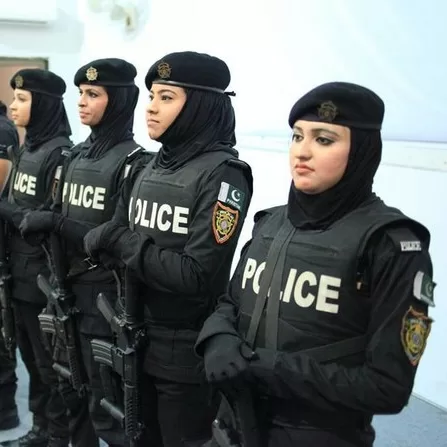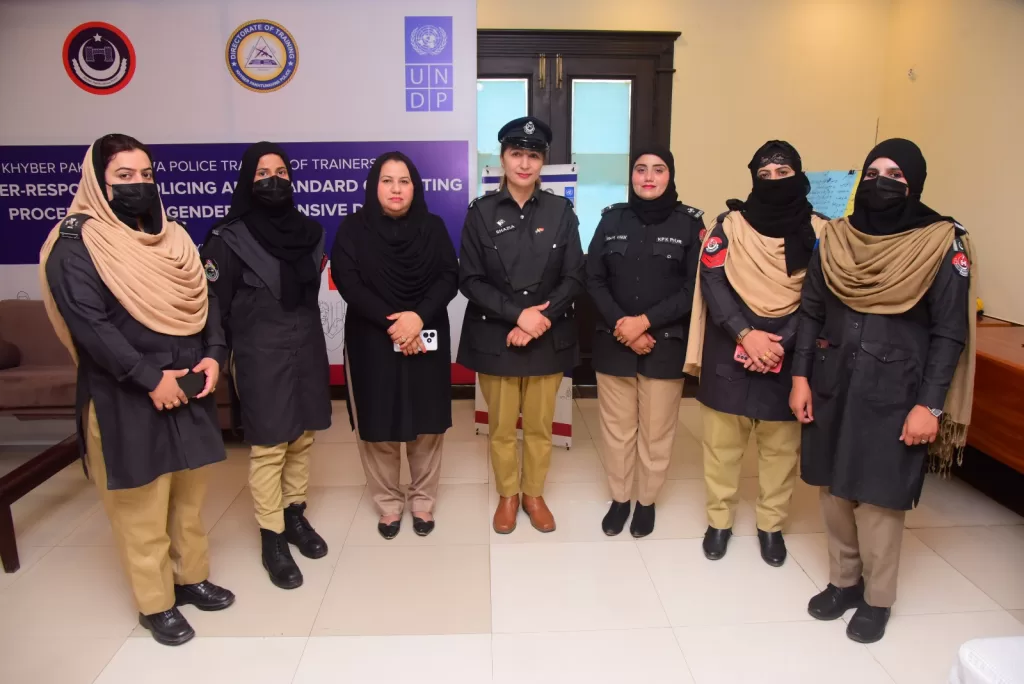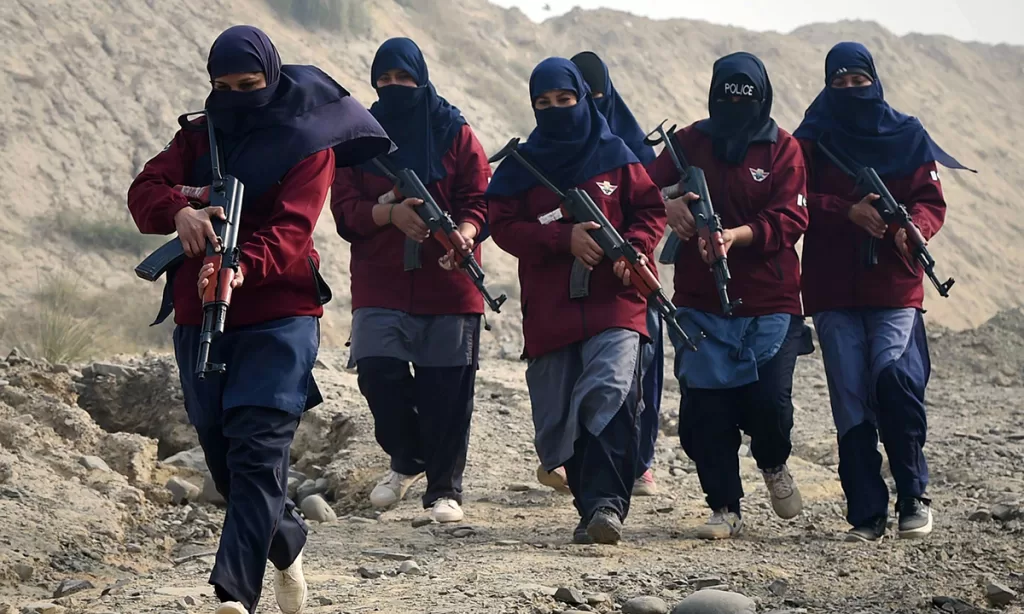Intorduction
Gender representation in policing is a critical aspect of law enforcement that directly impacts the effectiveness of policing, particularly in handling gender-based violence (GBV) and building community trust. In Pakistan, women make up only a small fraction of the total police force, which raises concerns about the inclusivity and responsiveness of the police to issues faced by women. This article examines the current state of gender representation in Pakistan’s police forces, focusing on the statistical data from various regions, and analyzes the implications of this underrepresentation.
Statistical Overview of Gender Representation in Police
According to the data received from police organizations Pakistan, the statistical data from 2023 highlights the significant underrepresentation of women in Pakistan’s police forces. Women account for only 3.2% of the total police strength, with 15,509 female officers out of a total of 489,645 officers. This low percentage reflects a broader issue of gender imbalance within the law enforcement sector, which varies across different regions of the country (UN Women).
A. Regional Disparities in Female Representation
• Punjab: The province with the largest police force has a female representation of 4.40%. While higher than some other regions, it still falls short of reflecting a balanced workforce.
• Sindh: Women make up 2.62% of the police force in Sindh, highlighting a significant gap in gender representation.
• Khyber Pakhtunkhwa: The situation is more critical here, with only 1.46% of the police force being female. This is one of the lowest percentages among the provinces.
• Balochistan: Female representation stands at 1.74%, indicating similar challenges as in Khyber Pakhtunkhwa.
• Islamabad Capital Territory (ICT): The capital city fares slightly better with 5.04% female representation, yet this is still far from equitable.
• Azad Jammu & Kashmir (AJK): Women constitute 2.48% of the police force.
• Gilgit-Baltistan: The region has a female representation of 3.36%.
• Pakistan Railways Police: Women make up 3.77% of the force.
• National Highways & Motorway Police: This organization has the highest representation at 6.31%, but even this figure underscores the overall low participation of women in policing.

B. Female Leadership in Policing
Leadership positions within the police force are predominantly held by men, with no women occupying the highest ranks (BPS 20-22). Women in BPS 17-19 constitute only 3.8% of the total, reflecting the glass ceiling that exists within the police hierarchy. In the lower ranks (ASI to Inspector), the representation drops further to 2%.
C. Training and Professional Development
The disparity in gender representation extends to training opportunities as well. In foreign training programs, only 262 women participated compared to 2,407 men. Local training programs show a similar trend, with 7,440 women participating compared to 80,792 men. This gap in training not only limits the career advancement of women in policing but also their effectiveness in handling specialized roles.
D. Recruitment Trends
Over the last four years, 11,321 women have been recruited into the police force, representing 15.1% of the total recruits. While this indicates a slight improvement in efforts to include more women, retention and promotion remain significant challenges. This statistical overview paints a clear picture of the challenges. in achieving gender parity within Pakistan’s police forces. The low percentage of women, particularly in leadership and specialized roles, raises concerns about the ability of the police to effectively address gender-specific issues and foster an inclusive work environment.
Impact of Low Female Representation
The low representation of women in Pakistan’s police forces has significant implications for the overall effectiveness of policing, particularly in areas related to gender-based violence (GBV) and community trust. This section analyzes how the current gender imbalance affects the police force’s ability to serve all members of society effectively and equitably.
A. Challenges in Addressing Gender-Based Violence (GBV)
The low percentage of women in policing severely limits the police force’s ability to handle cases of gender-based violence with the sensitivity and understanding required. With women making up only 3.2% of the force, there are few female officers available to take on roles that require interaction with female victims of violence. This shortage is particularly problematic in conservative regions where cultural norms may discourage women from reporting crimes to male officers. Statistics indicate that less than 2% of women who experience violence in Pakistan seek help from the police. This low reporting rate can be attributed to a lack of trust in the police’s ability to handle these cases sensitively.

Female officers are crucial in building this trust, as they are often perceived as more approachable and empathetic by female victims. Without sufficient female representation, the police force struggles to provide the victim-centered services necessary to encourage reporting and ensure that cases are handled appropriately.
B. Erosion of Community Trust
The underrepresentation of women in police forces also impacts community trust. A police force that lacks diversity, particularly gender diversity, may be seen as less legitimate and less capable of understanding and addressing the needs of the entire community. This perception is particularly strong in areas where women’s rights and safety are pressing concerns. When women are not adequately represented in the police, it sends a message to the community that the police may not be fully equipped to handle issues that disproportionately affect women, such as domestic violence, sexual harassment, and other forms of GBV. This lack of representation can lead to a perception of the police as a male-dominated institution that is out of touch with the realities faced by half of the population.
C. Limitation in Policing Capabilities
The lack of women in policing not only affects the handling of GBV cases but also limits the overall capabilities of the police force. Women bring different perspectives and approaches to policing that are essential for a well-rounded and effective law enforcement strategy. Their presence in leadership and operational roles can enhance the police’s ability to deal with a wider range of issues, from community policing to crisis management.
Moreover, the current gap in training and professional development opportunities for women exacerbates this issue. With fewer women participating in advanced training, the police force misses out on developing a diverse pool of talent that could contribute to more innovative and effective policing strategies.
Barriers to Increasing Female Participation in Policing
A. Cultural Perceptions and Societal Norms
Policing in Pakistan is widely perceived as a male-dominated profession. Cultural stereotypes and societal norms often view policing as unsuitable for women, particularly due to the demanding nature of the job, the need for physical strength, and the perception of policing as a high-risk occupation. These views are deeply entrenched, discouraging many women from pursuing careers in law enforcement.
Furthermore, in many regions, the idea of women working alongside men in close quarters or handling duties that involve night shifts, patrolling, and direct interaction with male colleagues is met with resistance. These societal attitudes not only deter women from joining the police but also influence how female officers are perceived and treated within the force.

B. Structural Barriers Within the Police Force
The police force’s organizational structure and policies often fail to accommodate the needs of female officers, making it difficult for women to remain in the profession or advance to higher ranks.
- 1. Inadequate Facilities and Support Systems:
• Many police stations lack basic facilities for women, such as separate washrooms, changing rooms, and rest areas. The absence of such essential infrastructure creates an unwelcoming and sometimes hostile work environment for female officers.
- • There is also a significant lack of childcare facilities or provisions for flexible working hours, which are crucial for women who need to balance professional responsibilities with family obligations. This lack of support can lead to higher attrition rates among female officers, particularly those with young children.
- Inflexible Work Policies:
• The demands of policing, which often require long hours, night shifts, and deployment in remote areas, are particularly challenging for women, especially in a society where they are expected to fulfill traditional roles in the household. The absence of flexible work policies that consider the unique needs of female officers further exacerbates this challenge.
- • Transfer and posting policies often do not consider the social constraints on women’s mobility, making it difficult for them to accept assignments that require relocation.
Gender Bias in Promotion and Career Advancement:
• Women in the police force frequently face gender bias, which affects their chances of promotion and career progression. Despite meeting the qualifications, women often find themselves overlooked for leadership roles, as seen in the statistics where no women occupy BPS 20-22 positions, and only 3.8% are in BPS 17-19.
- • This bias is reinforced by the lack of mentorship programs and leadership training specifically tailored for women, which are essential for breaking the glass ceiling within the police hierarchy.

C. Recruitment and Retention Challenges
Although there has been an increase in the recruitment of women in recent years (15.1% of recruits in the last four years), retaining these recruits poses a significant challenge. The demanding nature of police work, coupled with the lack of support and opportunities for advancement leads many women to leave the force before they can progress to higher ranks.
The recruitment process itself may also be biased against women, with physical fitness standards and other criteria often not adapted to consider gender differences. This can result in fewer women qualifying for police roles, further exacerbating the gender imbalance.
These barriers create a cycle that is difficult to break: low female representation leads to a lack of role models and mentors for other women, which in turn discourages new recruits and perpetuates the status quo.
Strategic Recommendations for Improving Gender Representation
Addressing the significant gender imbalance in Pakistan’s police forces requires targeted and strategic interventions. These recommendations focus on recruitment, retention, and the creation of a supportive work environment that can help increase female participation and enable women to thrive in their roles.
A. Targeted Recruitment Strategies
1. Revised Recruitment Policies:
• Recruitment criteria should be revised to include flexible physical standards that account for gender difference es, such as height and fitness levels. This would help ensure that more women can qualify for police roles without compromising on the overall standards of the force.
• Implement specific annual targets for female recruitment to ensure that the 10% job quota for women is met or exceeded. These targets should be enforced with clear accountability mechanisms within the recruitment process.1
2. Inclusion of Women in Recruitment Processes:
• Women police officers should be actively involved in recruitment committees to ensure that gender sensitivity is maintained throughout the selection process. Their presence can help mitigate unconscious bias and ensure that the recruitment process is fair and inclusive.
- 3. Community Engagement and Awareness:
• Initiate community engagement programs to raise awareness about the importance of women in policing. This could include outreach to educational institutions to encourage young women to consider careers in law enforcement.
• Address societal stereotypes through public awareness campaigns that highlight the contributions of women in the police force and challenge traditional gender roles.
B. Creating a Gender-Sensitive Work Environment
1. Infrastructure and Facilities:
• Police stations and training institutes should be equipped with gender-sensitive facilities, including separate washrooms, changing rooms, rest areas, and childcare facilities. These basic amenities are crucial for creating a welcoming and supportive environment for female officers.
• Ensure that these facilities are included in the Annual Development Plan (ADP) of police organizations to guarantee sustained investment and improvement over time.

- 2. Flexible Work Policies:
• Develop and implement flexible work policies, such as compressed workweeks and flexible start and end times, to accommodate the needs of female officers, particularly those with family responsibilities.
- • Review and revise transfer and posting policies to account for the social and cultural constraints faced by women. Where possible, female officers should be posted closer to their homes to reduce the impact of work on their personal lives.
- 3. Enforcement of Anti-Harassment Laws:
• Strictly enforce anti-harassment laws within the police force to ensure a safe and respectful work environment for women. This includes establishing clear procedures for reporting and addressing complaints of sexual harassment.
• Publicize these procedures widely within the police force to ensure that all officers are aware of their rights and the mechanisms available to them for seeking redress.
C. Enhancing Training and Leadership Opportunities
1. Specialized Training Programs:
• Develop and implement specialized training programs aimed at building leadership and technical skills among female officers. This could include courses in conflict resolution, investigation techniques, community policing, and legal knowledge.
- • Ensure that women are proportionately represented in all training programs, including induction, promotion, and refresher courses. Setting annual targets for female participation in these programs can help monitor progress and ensure accountability.
- 2. Mentorship and Career Development:
• Establish mentorship programs that pair senior female officers with junior recruits to provide guidance, support, and career advice. These programs can help women navigate the challenges of the police force and prepare them for leadership roles.
- • Encourage women to take on leadership positions by providing clear pathways for career advancement, including performance-based incentives and opportunities for specialized assignments.
D. Policy Reforms and Accountability
1. Gender-ResponsiveBudgeting:
• Implement gender-responsive budgeting within police organizations to ensure that resources are allocated equitably and that the specific needs of female officers are addressed. This includes funding for gender-sensitive facilities, training programs, and outreach initiatives.
- 2. Monitoring and Evaluation:
• Establish clear performance indicators to track the progress of gender-inclusive policies and initiatives. Regular monitoring and evaluation should be conducted to assess the effectiveness of these measures and identify areas for improvement.
- • Involve senior police leadership in the oversight of these initiatives to ensure that gender inclusivity remains a priority at all levels of the organization.
- 3. Dedicated Units for Gender-Based Violence (GBV):
• Establish dedicated units within police stations to handle GBV cases, staffed by trained female officers. These units should be equipped to provide sensitive and effective responses to victims, ensuring that their needs are met throughout the investigation process.
- • Develop standard operating procedures (SOPs) for these units that outline the specific roles and responsibilities of officers in handling GBV cases, including victim support, evidence collection, and coordination with other service providers.
Conclusion
The underrepresentation of women in Pakistan’s police forces is a critical issue that hampers the effectiveness and inclusivity of law enforcement across the country. With women constituting only 3.2% of the total police force and facing significant barriers to entry, retention, and advancement, the current state of gender representation is far from adequate.
This imbalance not only undermines the police’s ability to address gender-based violence effectively but also erodes public trust and limits the overall capabilities of the force.
To address these challenges, it is essential to implement targeted recruitment strategies, create a gender-sensitive work environment, and provide robust training and leadership opportunities for female officers.
Policy reforms, including gender-responsive budgeting and dedicated units for handling gender-based violence, are also crucial for fostering a more inclusive and effective police force.
Source:
National Police Bureau (NPB) – Ministry of Interior Government of Pakistan





